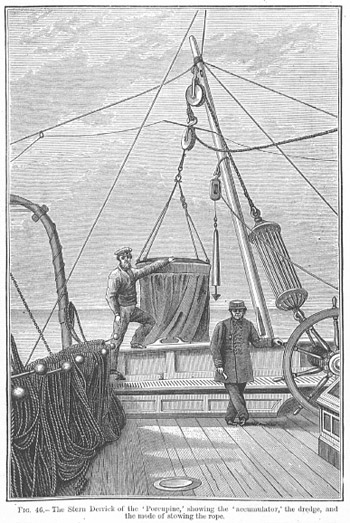The Depths of the Sea: An Account of the General Results of the Dredging Cruises of H.M.SS. 'Porcupine' and 'Lightning' During the Summers of 1868, 1869, and 1870, Under the Scientific Direction of Dr. Carpenter, J. Gwyn Jeffreys, and Dr. Wyville Thomson
The Depths of the Sea chronicles the cruises of the British ships Lightning and Porcupine in the North Atlantic Ocean and the Mediterranean Sea. The voyages explored deep-sea flora and fauna, fossils, and the nature of the sea floor and determined "the composition and temperature of sea water at great depths."
 Title page
Title page
View High-Resolution Image (TIF, 709 KB) Page 402
Page 402
View High-Resolution Image (TIF, 251 KB) Page 403
Page 403
View High-Resolution Image (TIF, 569 KB) Page 404
Page 404
View High-Resolution Image (TIF, 543 KB) Page 405
Page 405
View High-Resolution Image (TIF, 544 KB) Page 406
Page 406
View High-Resolution Image (TIF, 4.02 MB) Page 418
Page 418
View High-Resolution Image (TIF, 553 KB) Page 419
Page 419
View High-Resolution Image (TIF, 6.08 MB) Page 420
Page 420
View High-Resolution Image (TIF, 554 KB) Page 421
Page 421
View High-Resolution Image (TIF, 5.04 MB)
This excerpt includes the title page and pages 402-406 and 418-421 from The Depths of the Sea.
View the Flash version.
The Depths of the Sea encompasses the early work of C. Wyville Thomson and describes the dredging cruises that he led aboard the H.M.SS. Porcupine and Lightning during the summers of 1868 through 1870. Thomson was educated in the natural sciences at the University of Edinburgh. He held professorships in botany, natural history, zoology, and geology at universities in Ireland and Scotland. Thomson became fascinated with the study of deep-sea animals and fossils. After visiting the Norwegian scientist Michael Sars and viewing his collection of animals dredged from depths greater than 300 fathoms, Thomson embarked on a campaign to convince the British government and the Royal Society to support a deep-sea dredging expedition. These efforts resulted in the cruises of the Lightning and Porcupine.

Equipment for collecting specimens aboard the Porcupine. The dredge-rope (left) was nearly three and one-half statute miles long and weighed about 5,500 pounds. To store the rope when the dredge was not in use, the crew coiled it in two- to three-hundred fathom segments on iron pins known as 'Aunt Sallies.' (p. 249)
By the 1870 cruise, Thomson and his colleagues dredged in waters over 2,400 fathoms deep and brought back a remarkable array of marine life. This work provided the evidence that disproved Edward Forbes’ azoic zone hypothesis that life did not exist below 300 fathoms in the deep ocean. Thomson captures this remarkable achievement in this excerpt:
"Dr. Carpenter and myself, with the effective support of the present Hydrographer to the Navy, who is deeply interested in the scientific aspects of his profession, we had placed at our disposal by the Admiralty sufficient power and skill to make the experiment, we found that we could work, not with so much ease, but with as much certainty, at a depth of 600 fathoms as at 100; and in 1869 we carried the operations down to 2,435 fathoms, 14,610 feet, nearly three statute miles, with perfect success." (p.3)
The following passage further illustrates the rich content and elegant language of this book:
"For the bed of the deep sea, the 140,000,000 square miles which we have now added to the legitimate field of Natural History research, is not a barren waste. It is inhabited by a fauna more rich and varied on account of the enormous area, and with the organisms in many cases apparently even more elaborately and delicately formed, and more exquisitely beautiful in their soft shades of colouring and in the rainbow-tints of their wonderful phosphorence, than the fauna of the well-known belt of shallow water." (p.4)
The cruises of the Porcupine and Lightning set the stage for the great Challenger expedition of 1872-1876, also led by Thomson, that helped lay the foundation of modern oceanography.
- Author: Sir (Charles) Wyville Thomson (1830-1882)
- Date Published: 1873
- Publisher: MacMillan and Co.
- Location: New York and London
- Length: 527 pages
View Complete Rare Book
Related Web Sites
